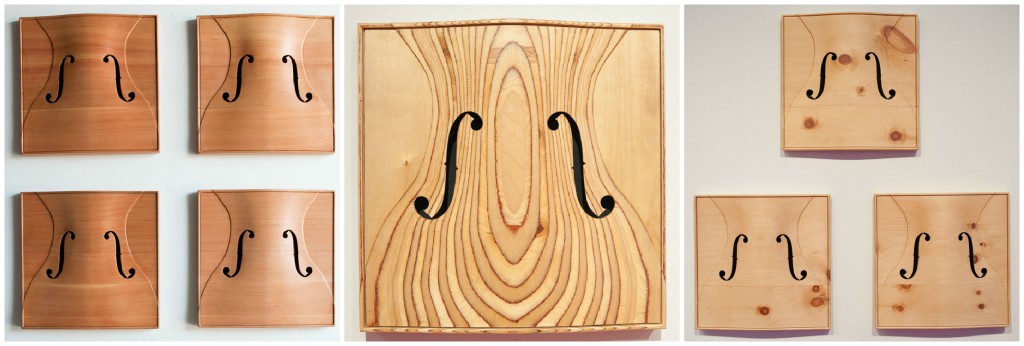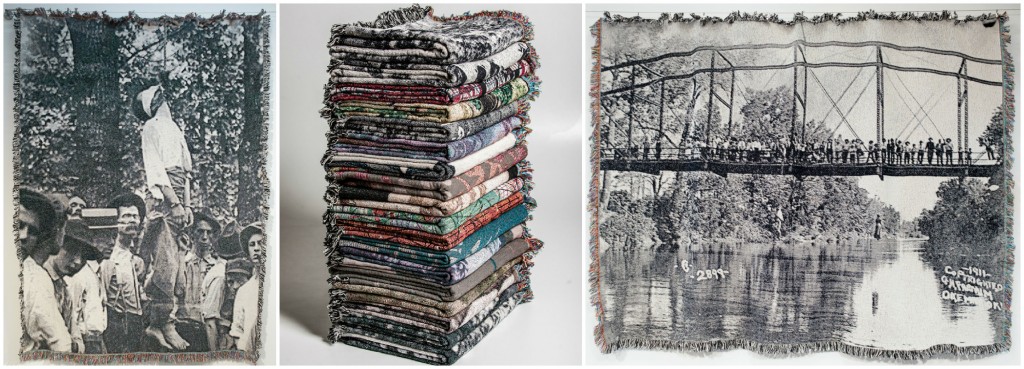Paul Rucker’s Rewind Exhibit Addresses the History and Effects of Racism in America
I was approached by a Ku Klux Klan member in 1980. I was six years old, walking up Main Street in Westminster, MD, with my family. The man wasn’t wearing a hood or a uniform. He looked nice enough, so when he stooped low and handed me a pamphlet I smiled back and accepted it. I had never seen my father yell at a stranger in public before, but in a split second he had ripped the paper out of my hands and threw it on the ground. I was horrified and embarrassed to see my father threaten another man in public. I had no idea what was going on.
This memory stayed with me because of its ugly strangeness, but until I visited Rewind, Paul Rucker’s new exhibit at Creative Alliance, I had not considered its significance. As a white person from a middle class Maryland home, the world I grew up in was mostly egalitarian, progressive, and kind. Rucker’s work made me reconsider a shared past from the perspective of the black people living in my town, and it was shocking for me to realize that their history might have included burning crosses and constant vigilance against anonymous threats of violence. If the KKK could exist in broad daylight in my town as late as the 1980’s, what was this group doing at night? Growing up white, I never had to consider their existence. I never had to fear a group of people who wanted to hurt me because of who my parents were or what I looked like.
Paul Rucker: Rewind is a scorcher of an exhibition that leaves no room to hide from shameful American truths. Centered on events of racial violence from our distant slave owning past to Jim Crow era discrimination to present day incarceration rates and recent police killings of people of color, this exhibit presents numerous opportunities to revisit and reconsider the impact of four hundred years of white supremacy in America. In addition to a dense array of well-documented historical research, Rucker’s output also offers metaphor and nuance through unusual aesthetic and material choices that code history with personal reflection, adding the artist’s feelings of anger, sadness, hope, and solemnity to the narrative.
The large installation, ‘Storm in the Time of Shelter,’ dominates the Creative Alliance’s Main Gallery, where the floor is painted blood red. Mannequins wearing mostly red, white, and blue Klan robes, handmade by Rucker and his sister-in-law, are arranged in a large circle. The hulking figures center around a large metal cross on the floor, with their blank faces covered by elaborate hoods. Most disturbing, at the foot of the cross, a circle of three children in full Klan regalia hold out their hands, as if playing Ring Around the Rosy.
Rewind’s confrontational presentation of these figures brings history to life in a visceral way. The inclusion of the child figures is essential in understanding that terrorizing and publicly murdering African Americans was a commonly accepted way of life, a regular part of growing up in many states in order to maintain white dominance. Viewed together with gallery wall text – high profile quotes of black victims of recent police shootings – Rucker’s figures physically embody the legacy and influence of the Klan, suggesting that the public practice of violence against people of color continues today.
Other bodies of work in Rewind are less obvious, though no less effective. In the ‘Soundless Series,’ wooden memorials to murder victims of civil rights era violence look like small paintings from a distance. Closer inspection reveals curved relief surfaces, rich with the intricate texture of natural polished wood, and incised F-holes that open up the body of a cello. Since Rucker is a cellist, his familiarity with the instrument as well as its curvy hips and approximate human size makes it an excellent stand in for a figure.
Each wooden box is titled with a date and a place, signifying the death of the person represented. A neutral title allows the viewer to appreciate the unique physical beauty of each object, creating a sense of reverence and curiousity about the dates. Rucker provides specific information about each work of art in an accompanying newspaper written by the artist, available for free in the gallery. The periodical is dense with historical data and images that enhance the factual significance of each project in the exhibit.
Rucker’s ‘Excessive Use’ series is a collection of human-sized paper gun-range targets. Each target is a memorial to a black victim shot by a police officer, titled with the date and location of the shooting. Rucker obtained a concealed weapons permit in order to make this work, and bought a gun in order to shoot each target with the exact number of bullets used in each instance. The loosely waving paper on simple wooden frames is at first zenlike, as the gallery lights create dramatic shadows on the walls behind each. The piece draws you in to inspect each hole, and to consider why so many bullets were shot into unarmed people.
Animations and videos screen in a back theater area in the Main Gallery. ‘Proliferation’ is a dark map of the United States with small twinkling lights in red, green, orange, and yellow that form clusters, representing prison populations as reported in Census data. As you compare the relative darkness of the green 1778-1900 dots to present day red dots signifying 1981-2005, it is clear that mass incarceration is a modern day phenomena. This piece also forces the viewer to question the high percentage of African American and Hispanic prisoners in our rapidly growing prison industry (they were 58% of all prisoners in 2008, even though African Americans and Hispanics are 25% of the US population), a growing population fuelled by racially biased ‘War on Drugs’ law and zero tolerance policing.
This sprawling exhibition continues upstairs in Rucker’s Creative Alliance studio, and it’s obvious why certain works were placed in a more private setting. Digitally printed quilts of lynching postcards, which were once commonly held and traded as souvenirs, hang on the wall depicting the deaths of a mother and son, of Leo Frank, a Jewish factory manager, and the Middle Passage. Printing these horrific images onto quilts lends them a barbed softness – the comforting warmth of a quilt starkly contrasts with the images of murder and violence, a reminder of the domestic intimacy of these horrific acts.
The installation ‘Little Known’ is located in the loft area of Rucker’s studio. It features dozens of tiny violin cases draped with American flags, laying in rows on the floor in front of a largely white video projection of sky and clouds. These are memorials for slave children who died young, with the video’s peace and emptiness offering a resting place for these young souls. Rucker’s newspaper includes an article revealing that before the Civil War, half of America’s slaves were under the age of 16. They usually grew up apart from their parents, especially their fathers, and entered brutal fieldwork between the ages of 8 and 12. These malnourished children were smaller than average. With ‘Little Known,’ Rucker creates a poignant memorial for these victims, representing them using his own musical affinity for stringed instruments.
There are many more bodies of work in Rewind and each has a specific topic that relates to the larger impact of racial violence committed by whites against people of color. Rucker’s message is an emphatic and accessible one – these deaths are crimes, these lives should be valued, this violence needs to stop – and it echoes many of the recent protests enacted after high profile police shootings of unarmed black men in the past year.
By sending this message through a range of tactile objects that compel, horrify, and entrance, the artist presents historical information in an active, personal way, which allows the viewer to discover her own connections between the past and present, like solving a puzzle. Rucker’s installations, videos, sculpture, and performances encourage the viewer to integrate facts, statistics, and historical narratives in meaningful and unforgettable ways, but at their own pace and through a variety of channels.
As a solo exhibit, Rewind is overwhelming, over the top, gruesome, poignant, and mostly unsubtle, which is appropriate, considering it mirrors 400+ years of white supremacy in America and its legacy of racial violence against people of color today. For white Americans especially, this exhibit provides ample opportunity to reconsider and revisit our notions of racism in the past, and to realize that many of these practices are still hiding in plain sight. Rather than feeling depressed, Rewind offers an opportunity to empathize, educate, discuss, and energize against the policies, economics, and attitudes that continue to kill and incarcerate people of color in this country.
Author Cara Ober is the Founding Editor at BmoreArt.
Disclaimer: Rucker is a 2013 Deutsch Foundation Artist in Residence at MICA. BmoreArt is funded in part by the Deutsch Foundation and author Cara Ober is an adjunct professor at MICA.
Photo Credits: Ra Rah http://www.rarahphoto.com/
Additional Events in conjunction with Rewind:
Artist Talk at Johns Hopkins University
Maverick Barn Baltimore Artist Meet-Up
February 26 at 7:00pm
Yoga/Meditation/Cello at Creative Alliance
February 28 from 10:00am – 11:30am
Artist Talk: REWIND at Creative Alliance
February 28 from 4:00pm – 5:00pm










